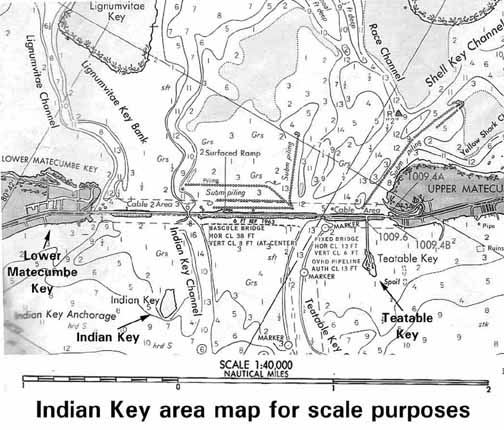- History of Tea Table Key
- By Jerry Wilkinson
- -
 - The
author
has very little
documented information of Tea Table Key and solicits additional input
from
readers. To provide assistance, please click the prepared e-mail tab at
the bottom of this page. First to assist readers not certain of the
location
of Tea Table Key, the above is excerpted from a 1968 navigation chart.
Much of the island's documented history was its role in the Second
Seminole
War (1835-1842); therefore, a review of this war.
- The war began
in
December 1835
with an attack of troops being led from Tampa to Ocala by Major Francis
Dade, the namesake of Dade County. The first recorded action for South
Florida was in January 1816 was the slaughter of the William Cooley
family
in the Fort Lauderdale area. The reaction was an estimated 200 people
fled
the area to Indian Key and Key West. The next incident was the attack
on
the Cape Florida Lighthouse in July 1836 resulting in the killing of
the
assistant light keeper and the burning of inside of the lighthouse.
Captain
Jacob Housman then organized an unit of the volunteer Florida Militia
on
Indian Key. The following year, the third major incident was the
killing
of Captain John Whalton, the lightship keeper at Carysfort Reef, and
one
crewman on Key Largo in June 1937. One could conclude that the war was
now in the Keys.
General Zachary
Taylor, the commanding
General of the Florida War, assigned two navy ships, the Madison
and the Campbell to cruise the Keys in June 1838. In December
1838,
Lt. Napoleum L. Coste, the commander of the Campbell, wrote the
Secretary of
the Navy, James Paulding, that he had established his headquarters at
Tea
Table Key and had named it Fort Paulding. No one knows how pleased the
Secretary would have been had he known that the fort bearing his name
was
a 3.55 acre mangrove island with two post coconut thatch-roof
structures;
however, that's the way it was. By far the majority, if not all, of
existing log book
entries referred to it as Tea Table Key and not as Fort Paulding.
As a note, James Kirke
Paulding served both the government and a civilian career. He was
talented and prolific American literary figure. He was the 11th
Secretary of Navy under President Martin Van Buren and served during
the President's term of office. He had extensive naval technical and
managerial knowledge.
Before I continue, new
information has
shown up that Tea Table Key was already owned by Indian Key personnel
and
being farmed by Lemuel Otis. Copies of the legal confrontation that
ensued
has been requested and will be posted as revisions to this page as soon
as received. - The
"fort"
evidently expanded to
more than two structures. Not much is known of these; however, Lt.
Coste
was accused of using military personnel to build himself a personal
home. The
following is a transcription of a letter from the Office of the Revenue
Cutters: "Key West, November 10, 1839 - I certify that Lt. Coste while
in command of the USRC [United States Revenue Cutter] Campbell,
I being acting 1st Lt. under his command and at all times present
whenever
any men were employed on Tea Table Key and no men were ordered by me or
Lt. Coste to work on his house, or the contrary he frequently
instructed
me not to permit any of the crew to assist at his individual property
but
that at several times part of the crew belong to the vessels were
employed
constructing a palmetto house, the frame of which was brought from Cape
Florida to Tea Table Key (the fact of which the Department was advised)
which houses was intended for boat and store houses where provisions
were
stored when brought up and boats stored for repairs - Nor were the
carpenter
of the crew of the USRC Campbell employed.
-
"VR
-
"John Faunce"
- Others
letters
exist from Key West
civilians attesting to the purchasing of materials, hiring and payment
from a private account of Lt. Coste of civilian personnel to work on
Lt.
Coste's house.
- When Lt.
McLaughlin was made commander
of the military forces in the Keys he made Tea Table Key his
headquarters.
After the Indian Key raid of August 7, 1840, McLaughlin leased the
remains
of Indian Key for his headquarters. Many believe that Tea Table Key was
vacated and everyone moved to Indian Key. Documentation reveals that
this
is not totally true. From the log of the Flirt commanded by Lt.
McLaughlin: "November 17 [1841] - Drilled men at small arms at Tea
Table
Key." Perhaps, just the drill field and flagstaff remained.
-

- During the attack of
Indian
Key in August 1840,
Midshipman Murray attempted to attack the maundering Indians using some
ill servicemen and a cannon that failed. Below is a letter he sent to
his superior officer, Lt. McLaughlin.
- "Lieut. Comd.
J.T. McLaughlin
Key Biscayno
;
Tea Table Key
;
August 7th 1840
"Sir,
I have the honor to report that Indian Key was last night taken by the
Indians, - of which fact I was appraised from the Medium at
daylight
this morning, our force here consisted of five men, with whom
joined
to seven or eight of the sick, who volunteered readily, but were
too
weak to be of much service, I started for the key; - at first, with the
intention of landing, which however was opposed by the enemy who had
taken
refuge in every house, and opened a heavy fire which fell thick around
us, striking our boats, & wounding one man severely and dangerously
in the thigh. They appeared also in great
numbers on
the beach, yelling and firing, which firing we returned with
three discharges of
our four
pounders, in the Barges. At the third discharge, being obliged to
fire them athwart ships, our
guns rebounded
overboard; being deprived of the means of cutting off their
retreat, I
returned to
Tea Table Key, to make preparations for the attack which I think
more than
probable it
is their intention to make upon us; being assured, that our amount
of force, and means,
rendered
us of no assistance to the inhabitants of Indian Key, if any
survived, which
is not to
be supposed. The families of Messrs
Housman and Howe & two Seamen have alone escaped.
I have the honor to
be
-
Sir,
Very Respectfully,
-
(Signed) Francis Key Murray
Mid, U.S.N.
" P. S. The Indian force at the lowest estimate judging from the number
of Canoes is fifty or sixty, I am obliged to write in great
haste.
The Indians used the long guns on the Key firing them at us repeatedly
with good aim. "
As previously stated, I
see no additional use of the name Fort Paulding.
To read more military
letters of
the time period, CLICK HERE,
and use the back arrow to return. -
This page is still
under construction
and will be updated as additional information is found. At the present,
2003, the island is a private residence (two buildings) connected by a
causeway from
highway
US-1 at about MM 79.3 in the mid 1950s..
-
Use Back Arrow to
return to reading previous page or:
To return to the Specific Locations and Keys homepage, Click
HERE.
|


